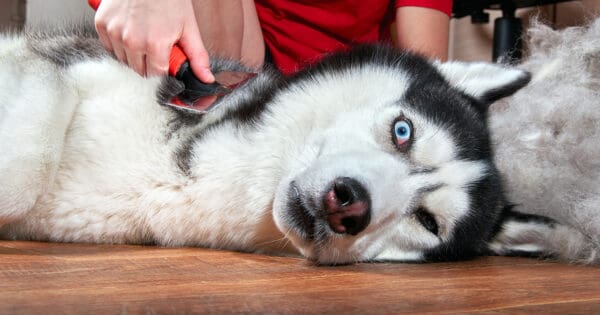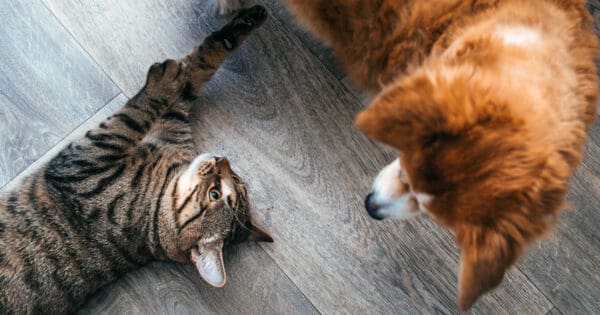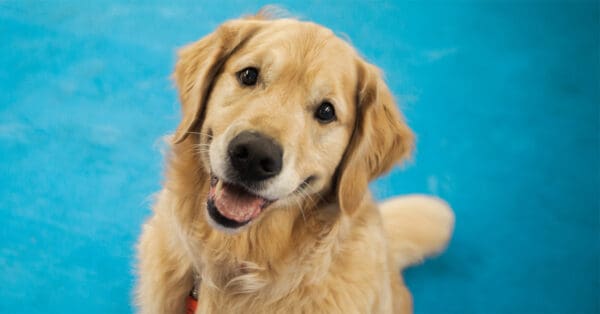
11401 NE 195th St. Bothell, WA 98011
(425) 486-9000 PHONE (425) 486-9002 fax
Notice: Below care sheet is from 2016, and may not reflect up-to-date care information.
Quick facts
- The Bearded dragon (Pogona vitticeps) is a terrestrial, omnivorous, diurnal lizard native to Australia.
- Bearded dragons, also known as beardies, are one of the most popular lizards to keep as pets.
- Adults typically average lengths of 46-56 cm and weigh 300-500 grams.
- A variety of color variations, or “morphs,” are available due to selective breeding.
- Bearded dragons may perform “head bobbing” and “arm-waving” behaviors. These displays can mean different things depending on the social situation.
- A beardie’s beard can change color depending on his/her mood. Aggressive or agitated bearded dragons will often display a black beard.
- With proper care, a bearded dragon can easily live over 10 years.
Enclosure
A juvenile bearded dragon should be housed in a 10 gallon glass aquarium tank. The tank size will have to increase as the beardie grows. Adults require a 20-50 gallon long glass aquarium tank. Because beardies love to climb, provide vertical space with lots of branches.
Substrate
The safest and easiest substrates to use are paper, newspaper, paper towel, or slate. If you prefer a more naturalistic look, go with slate. “Reptile Carpet” can be used, but must be changed and washed (preferably in a washing machine with detergent) at least weekly. Alfalfa-based rabbit pellets can also be used; they are safe if accidentally ingested, and help absorb odor. However, the pellets disintegrate and mold if they get wet, so you cannot have a water dish in the enclosure if you are using alfalfa pellets. Instead, you would have to soak your bearded dragon twice weekly to ensure that he/she is getting adequate water.
Aquarium gravel, walnut shells, calcium sand, and natural sand are not recommended, due to the risk of intestinal impactions if swallowed.
Heat
It is very important to provide a temperature gradient for your bearded dragon to allow him/her to regulate its own body temperature. The warm end of the enclosure should be maintained at 80-90°F, with the opposite side of the cage from 75-80° F. A basking spot of 100-115°F should also be provided by arranging a climbing branch or rock 8-12” underneath the heat source.
There are several different ways to provide proper heat. We recommend using a mercury vapor bulb to provide both full spectrum UV light and heat to your bearded dragon. This should be left on at least 12 hours per day. At night, we recommend using a 60-100 watt Ceramic Heat Emitter bulb, which will give off heat without light, to maintain appropriate enclosure temperatures.
Depending on your house temperature, you may also need some under-tank heating. Many types of heating pads/heat tape are available at pet stores and online. If an under-tank heater is used, it is very important to purchase a quality thermostat to help control the heat output and maintain safe and appropriate temperatures.
Do not use heat rocks! These commonly will overheat, causing burns to reptiles and creating a fire hazard.
The enclosure temperature should be monitored closely with an accurate thermometer to make sure that it is staying in the “optimum temperature zone” for your pet. We recommend using temperature guns or probe thermometers so that the actual temperature of the cage floor or basking spot can be accurately measured. Dial or tape thermometers placed on the wall of the enclosure do not accurately reflect the temperatures your pet is experiencing.
Lighting
UV light exposure is crucial for maintaining a healthy bearded dragon. Adequate exposure to full spectrum UV light is necessary for generation of Vitamin D3, which is in turn vital to the ability of the beardie to absorb calcium. Direct natural sunlight should be supplemented whenever possible. Remember that windows filter UV light, so getting sunlight through a window is not adequate.
Bearded dragons should receive 12 hours of UV lighting each day. If it is a sunny, warm day, we recommend taking your bearded dragon outside for natural sunlight exposure. There are some great sunning cages available, or you can build a simple cage with window screens. Make sure that some of shade is always available, and maximize the air flow.
If you are unable to provide natural sunlight, you will need to provide the UVB through artificial lighting. Mercury vapor bulbs are currently the best source for artificial UV light on the market, and are our top recommendation for bearded dragons. Alternatively, a 10.0 fluorescent bulb can be used.
It is important to note that fluorescent UV lights will stop producing UV spectrum lighting long before they stop producing visible light. As a result, we recommend replacing the bulbs every 4-6 months.
Diet
Bearded dragons are omnivorous in the wild. Therefore, they should be offered vegetables, fruits, and insects in their diet. Fruits should be kept to a minimum, focusing primarily on vegetables and insects.
Juveniles: Offer insects in the evening and a chopped green salad in the morning. Purchased hatchlings should be readily eating salad/vegetables, but if insects are present, the lizards generally won’t touch their vegetables. As salad/vegetables will make up the majority of the adult bearded dragon diet, it is very important to start exposing the babies at a young age to this food. It is also recommended to keep moistened bearded dragon pelleted diet available at all times.
Adults: Adult bearded dragons should receive a chopped green salad once daily, and insects three times weekly. A bearded dragon pelleted diet can be offered at all times.
More information on diet components:
- Chopped green salad: Offer a mix of fresh green vegetables and greens daily.
- This may include collard greens, kale, parsley, turnip greens, dandelion greens, plantain, mustard greens, escarole, and chicory.
- The bulk of your greens mix should be composed of the above ingredients, but also add some of the following: carrots (carrot peelings work great), yellow summer squash, butternut squash, green beans, dandelion, red clover, squash, hibiscus, and nasturtium blossoms.
- Be sure to wash any purchased greens, and make sure that you are not accidentally exposing your bearded dragon to chemicals or pesticides if you are collecting any of these materials yourself.
- The mix can be chopped in a food processor or hand chopped and stored in the refrigerator for up to a week. The mix may also be frozen in small batches and thawed prior to feeding. Some beardies that are accustomed to fresh greens may not readily eat pre-frozen food.
- Occasional fruit pieces, such as orange, mango, banana, or apple, may be offered no more than once weekly.
- Insects: We recommend feeding mealworms and cockroaches as the insect portion of the diet, mixed with other insects to provide variety (butterworms, hornworms, superworms, waxworms, phoenix worms, and crickets). Feed as many insects as the beardie will consume within a sitting. Make sure that the insect prey is appropriately sized for your beardie. The insects should not be larger than the width of the bearded dragon’s head.
- These insects should be “gutloaded”, or fed a complete, proper diet for at least 24-48 hours prior to feeding them to your bearded dragon. A good basic diet for gutloading insects is layer chicken pellets supplemented with fresh fruits and vegetables. Please see our handout on gutloading insects (“You Are What You Eat”) for more information. Although there are a variety of commercial gutloading diets sold, they are not equal in their nutritional value. Please consult our veterinarians prior to selecting a commercially formulated gutloading diet.
- Please note: do not place your beardie outside where he/she may have access to fire flies, as they are highly toxic. Feeding wild-caught insects may introduce parasites and insecticide toxins. As a result, we recommend that you do not feed wild insects.
- Bearded dragon pellets: Several companies (Flukers, Zoo Med, Rep-Cal) make pellets for bearded dragons. These foods can supplement your animal’s diet. Beardies will successfully transition to eating pellets if the pellets are first softened in fruit juice (orange, mango, and apple). Subsequently, water may be used, and some beardies will eventually eat the pellets dry. If accustomed to fresh greens, the transition to pellets may take a few weeks. Mixing softened pellets with greens is suggested.
- It is important to note that bearded dragon pellets are NOT a complete diet. Both insects and vegetables must also be fed to keep your beardie healthy!
Supplementation
Lack of appropriate supplementation can lead to serious health problems in bearded dragons, including skeletal deformities and organ failure.
Both the insects and the salad/vegetables should be dusted with calcium dust 4-5 days/week. The calcium dust should contain no phosphorous or added vitamins.
Twice a month, a reptile multi-vitamin should be used to dust the food items instead. Do not supplement with vitamins more often, as fat soluble vitamins such as vitamin A and vitamin D can be toxic if overdosed.
Water
Bearded dragons receive most of their necessary water from food (provided that they are eating greens regularly). A water bowl should always be provided with fresh, clean water (unless you are using alfalfa pellet substrate). However, some beardies will not reliably drink from a water bowl. You can help make sure your beardie stays hydrated by misting water onto his/her head or soaking the animal in lukewarm water twice weekly.
Handling
Every day, carefully pick up your beardie and let it sit on your hand inside the cage. Allow it to leave your hand whenever it wants. This will allow your beardie get used to being held and released. Gentle daily handling will help your bearded dragon become tame.
Veterinary Care
>90% of all health problems seen in bearded dragons can be traced back to inappropriate husbandry. Following these care instructions is the best way to provide your beardie with a long, healthy, happy life.
We recommend performing annual to bi-annual exams bearded dragons as a preventative health measure. A thorough exam allows our veterinarians to catch health problems early, before they become more serious. We recommend performing regular fecal exams to check for parasites, and occasional bloodwork to assess systemic health.
Common Health Problems
- Nutritional secondary hyperparathyroidism (metabolic bone disease) – caused by inappropriate dietary supplementation of calcium
- Parasites – very common in bearded dragons
- Atadenovirus – an infectious viral disease that affects the central nervous system, immune system, and gastrointestinal tract of affected bearded dragons. Many bearded dragons are carriers of this virus. Unfortunately, the infection can be deadly, and there is currently no cure.
- Obesity – commonly occurs in bearded dragons that are eating inappropriate, excessive diets and not receiving adequate exercise.
- Dysecdysis – problems with normal shedding, usually caused by inappropriate humidity
- Trauma – from falling off of cage furniture, being dropped, or being attacked by other pets
- Impactions – usually caused by a combination of poor husbandry and inappropriate substrate choices
March 30, 2015
Content of this Care Sheet Courtesy of:
The Center for Bird and Exotic Animal Medicine
11401 NE 195th St. Bothell, WA 98011
(425) 486-9000 PHONE (425) 486-9002 fax



